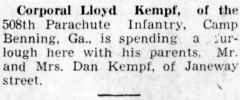|












| |
  
|
FORT BENNING
GA NEWSLINE (7) |
|
 4,000-Mile Transports 4,000-Mile Transports
Ready For USAF Soon
By ELTON C, FAY (AP Military affairs Reporter)
PANAMA (AP) -The Air Force expects to begin receiving soon a new model of its C130 transport plane which conceivably could speed paratroopers direct from U.S. bases to a battle drop in Europe.
A new model of the C130 transport, due for delivery within the next few months, will have a non-stop range up to 4,000 miles, compared with about 2,300 miles for the present C130s.
The Air Force currently has transports capable of the longer range, the C124s. They can carry tremendous loads for considerable distances. But they lack several critical features.
Powered by conventional piston engines, they are slower than the
C130s driven by jet turbines linked to propellers. Their troop
carrying compartments are not pressurized to make possible carrying
passengers at high altitudes which are safer in combat and often make possible higher speeds. Moreover, the giant C124s are not intended for use by paratroopers, for jumps into combat, as are the C130s.
The Army would like to test out its ability to fly a whole battle group of paratroopers (about 1,400 men) to Europe and parachute them down directly into a mock battle.
Maj. Gen. Robert F. Sink, head of the Strategic Army Command, was asked by newsmen if there were any plans to
|
make a European test similar to the just concluded
exercise Banyan Tree, in which 1,300 men were flown from the United States and dropped into Panama. He said "I have had a letter in on that for the last year and a half" with Army headquarters at the Pentagon.
Sink and Lt. Gen. Ridgeley Gaither, chief of the Combined Caribbean
Command, estimate it would take about 700 aircraft to airlift an
entire airborne division of 12,000 men.
This, the Army calculates, could be done with approximately 500 Cl30s and 200 C124s. The Air! Force does not have that many C130s now, although substantial numbers of additional planes are on order.
Aside from the problem of inducing the Air Force to build up its transport fleet, the Army is seeking to improve details of its airborne operations.
One long existing problem has been that of getting paratroopers out of parachute harness quickly, to prevent their injury by being dragged when wind fills chutes after landing. Beginning in the next four or five months, Sink said, paratroopers will be quipped with a new quick-release device. With one quick movement, a parachutist will be able to snap himself free of his parachute and most of its harness.
. The Army now is designing all its equipment and weapons except for tanks to fit into existing aircraft. This, says the Army, means that all its units will be air transportable.
[The La Crosse Tribune,
La Crosse, WI, 23 Feb 1959, Mon, Page 12] |
 AT FT. BENNING AT FT. BENNING
Now stationed at Ft. Benning, Ga., is paratrooper Pvt. Benjamin Grossman, son of Mr. and Mrs. Jacob C. Grossman, 314 Washington St. He was engaged in farming before joining the paratroopers
in April, 1944.
Pvt. Grossman has two brothers, Edwin, who recently received a medical discharge from the army, and Reuben, who serving in France.
[]The Bismarck Tribune, Bismarck, ND, 20 Dec 1944, Wed, Page 5 |

Corporal Lloyd Kempf, of the 508th Parachute Infantry, Camp Benning, Ga., is spending a furlough here with his parents, Mr. and Mrs. Dan Kempf, of Janeway street.
[The Kane Republican, Kane, PA, 12 Mar 1943, Fri, Page 8] |
|





